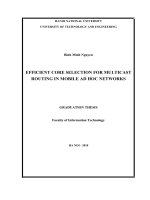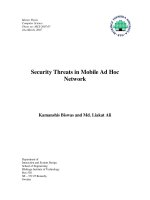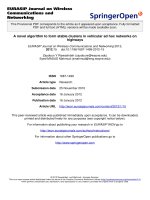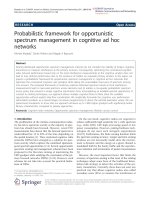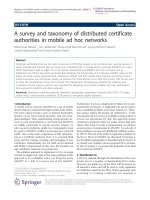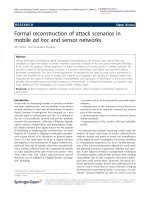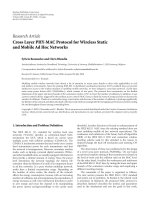Mobility adaptive clustering and network layer multicasting in mobile ad hoc networks
Bạn đang xem bản rút gọn của tài liệu. Xem và tải ngay bản đầy đủ của tài liệu tại đây (1.87 MB, 219 trang )
MOBILITY-ADAPTIVE CLUSTERING AND NETWORK-
LAYER MULTICASTING IN MOBILE AD HOC
NETWORKS
ER INN INN
NATIONAL UNIVERSITY OF SINGAPORE
2006
MOBILITY-ADAPTIVE CLUSTERING AND NETWORK-
LAYER MULTICASTING IN MOBILE AD HOC
NETWORKS
ER INN INN
(B. Sc. (Hons.), UTM)
A THESIS SUBMITTED
FOR THE DEGREE OF DOCTOR OF PHILOSOPHY
DEPARTMENT OF COMPUTER SCIENCE
NATIONAL UNIVERSITY OF SINGAPORE
2006
ACKNOWLEDGEMENTS
First, I would like to thank my thesis supervisor, Dr. Winston Seah Khoon Guan for
his constant dedication, guidance, advice and inspiration. I greatly appreciate all the
insights and criticism he have given me to improve the quality of this research and
thesis. This thesis would not have been possible without his help and motivation.
Special thanks go to the National University of Singapore for sponsoring my PhD
research. I would like to thank the Institute for Infocomm Research (I
2
R) for providing
a comfortable environment, sufficient resources and conference funding to me.
I would like to thank my fellow lab-mates of the past few years that accompanied me
on this challenging path. Thank you for giving me valuable advice and help whenever I
need them. They include Junxia, Kevin, Ricky, Choong Hock, Lixia, Qunying, Xiejing
and Huixian. I would like to thank my dearest friends: Peiwen, Suchin, Keeyit,
Benchin, Catherine, Sean doggie, Jimmy, Keone, Koktong, Yeechian, Ahming,
Engela, and Josephine for being part of my life and also part of my PhD journey.
Without your support and encouragements, I would not have gone this far.
Last but not least, I thank my family: Dad, Mum, Chinchin, Chinming, Sinyee, Andy,
and Chenhui for unconditionally supporting my decision to study PhD, for selflessly
loving me, for tirelessly encouraging me whenever I am feeling the sky is grey. For all
the sacrifices they have done for me, I dedicate this thesis to my family.
i
TABLE OF CONTENTS
Page
TITLE PAGE
ACKNOWLEDGEMENT i
TABLE OF CONTENTS ii
SUMMARY viii
LIST OF TABLES xi
LIST OF FIGURES xiii
LIST OF ABBREVIATIONS xvii
CHAPTER 1: INTRODUCTION 1
1.1 Introduction ……………………………………………………………………… 1
1.2 Clustering Issues in MANETs …………………………………………………… 4
1.3 Multicast Routing Issues in MANETs ……………………………………………. 6
1.4 Objectives and Scopes of the Research ………………………………………… 9
1.5 Contributions of the Research ………………………………………………… 11
1.6 Thesis Organization …………………………………………………………… 13
CHAPTER 2: LITERATURE REVIEW 15
2.1 Introduction ………………………………………………………………………15
2.2 Clustering Algorithms for MANETs …………………………………………… 15
2.2.1 Properties of Clustering Algorithms ……………………………………17
2.2.1.1 Cluster Architecture ………………………………………… 17
2.2.1.2 Cluster Coverage …………………………………………… 18
ii
2.2.1.3 Cluster Initialization ……………………………………… 19
2.2.1.4 Cluster Maintenance ……………………………………… 19
2.2.2 Existing Clustering Algorithms for MANETs ……………………… 19
2.2.2.1 Minimum-Connected Dominating Set Approach ………… 20
2.2.2.2 Maximum Weighted Independent Set Approach ……………23
2.3 Network-Layer Multicast Problem in MANETs ……………………………… 28
2.3.1 Multicast Group Management ………………………………………… 29
2.3.2 Multicast Path Setup Algorithm ……………………………………… 29
2.3.3 Multicast Routing Protocols ……………………………………………32
2.3.3.1 Flooding Protocols ……………………………………………33
2.3.3.2 Tree-based Protocols …………………………………………34
2.3.3.3 Mesh-based Protocols ……………………………………… 40
2.3.3.4 Hybrid/Adaptive/Hierarchical Protocols …………………… 44
2.3.3.5 Location-based Protocols ……………………………………. 46
2.3.3.6 Tree-based vs. Mesh-based Multicast Routing Protocols…… 48
2.3.4 Survey Summary and Open Issues …………………………………… 48
2.4 Summary …………………………………………………………………… 51
CHAPTER 3: MOBILITY-BASED D-HOP CLUSTERING ALGORITHM 55
3.1 Introduction …………………………….…………………………………………55
3.2 Assumptions …………………………………………………………………… 56
3.3 Preliminary Concepts and Definitions ….……………………………………… 59
3.4 Algorithm Description………………….…………………………………………60
3.4.1 Cluster Setup ……………….………………………………………… 61
3.4.1.1 Discovery Phase ………………………………………………61
3.4.1.2 Merging Phase ……………………………………………… 63
iii
3.4.2 Cluster Maintenance ……………………………………………………64
3.4.3 Proof of Correctness ……………………………………………………66
3.5 Summary ………………………………………………………………………… 70
CHAPTER 4: PERFORMANCE ANALYSIS OF MOBDHOP 71
4.1 Introduction ……………………………………………………………………….71
4.2 Evaluation Metrics ……………………………………………………………… 72
4.3 Simulation Results of MobDHop ……………………………………………… 74
4.3.1 Simulation Environment ……………………………………………… 75
4.3.2 Performance of MobDHop ……………………………………………77
4.3.3 Performance Comparison ………………………………………………82
4.4 Analysis of Time and Message Complexity………………………………………92
4.4.1 Assumptions ……………………………………………………………92
4.4.2 Definitions …………………………………………………………… 92
4.4.3 Hello Protocol Overhead ……………………………………………….94
4.4.4 Cluster Formation Overhead and Time Complexity……………………94
4.4.5 Cluster Maintenance Overhead and Time Complexity…………………95
4.4.5.1 Joining of New Node …………………………………………95
4.4.5.2 Link Failure ………………………………………………… 97
4.4.5.3 Link Establishment ………………………………………… 98
4.4.5.4 Total Cluster Maintenance Overhead ……………………… 99
4.4.6 Total MobDHop Clustering Overhead …………………………………99
4.4.7 Analysis Verification via Simulations ……………………………… 100
4.4.8 Comparison of Clustering Overhead by Five Clustering Algorithms…104
4.5 Unicast Performance using MobDHop ………………………………………….106
4.5.1 Protocol Operation …………………………………………………….107
iv
4.5.2 Simulation Environment ………………………………………………108
4.5.3 Simulation Results and Discussions ………………………………… 109
4.6 Summary ……………………………………………………………………… 111
CHAPTER 5: CLUSTER-BASED, GROUP-ADAPTIVE MULTICAST
ROUTING PROTOCOL 114
5.1 Introduction …………………………………………………………………… 114
5.2 GRAPE Multicast Routing Protocol …………………………………………….117
5.2.1 Protocol Messages and Data Structures ………………………………117
5.2.2 Construction of Cluster Structure …………………………………… 118
5.2.3 Multicast Group Management Mechanism……………………………119
5.2.3.1 Initiating a Multicast Group …………………………………120
5.2.3.2 Joining a Multicast Group ………………………………… 120
5.2.3.3 Maintaining a Multicast Group …………………………… 121
5.2.3.4 Leaving a Multicast Group …………………………………121
5.2.4 Multicast Packet Forwarding Mechanism…………………………… 122
5.2.4.1 Upper-tier Multicast Communication ……………………….122
5.2.4.2 Lower-tier Multicast Communication ………………………127
5.3 Summary ……………………………………………………………………… 129
CHAPTER 6: BANDWIDTH-OPTIMIZED AND DELAY-SENSITIVE
MULTICAST PATH SETUP ALGORITHM 130
6.1 Introduction …………………………………………………………………… 130
6.2 Network Model and Problem Formulation …………………………………… 132
6.3 BODS Multicast Path Setup Algorithm………………………………………….132
6.3.1 Nearest-Participant Heuristic ………………………………………….133
v
6.3.2 Selection of Delay Value………………………………………………136
6.3.3 Illustration by Example……………………………………………… 138
6.3.4 Integration of BODS into ODMRP.………………………………… 139
6.4 Simulation Results and Discussions …………………………………………….140
6.4.1 ODMRP and BODS Parameters ………………………………………141
6.4.2 Performance Metrics ………………………………………………… 142
6.4.3 Evaluation based on Random Waypoint Mobility …………………….143
6.4.4 Evaluation based on RPGM ………………………………………… 144
6.5 Summary ……………………………………………………………………… 150
CHAPTER 7: PERFORMANCE ANALYSIS OF GRAPE 152
7.1 Introduction …………………………………………………………………… 152
7.2 Performance Metrics …………………………………………………………….153
7.3 Simulation Setup and Protocol Parameters …………………………………… 153
7.4 Simulation Results and Discussions …………………………………………….157
7.4.1 Network Density ………………………………………………… 157
7.4.2 Mobility ……………………………………………………………….159
7.4.3 Traffic Load ………………………………………………………… 161
7.4.4 Multicast Scalability ………………………………………………… 163
7.4.4.1 Number of Multicast Receivers …………………………… 164
7.4.4.2 Number of Multicast Sources……………………………… 167
7.4.4.3 Number of Multicast Sessions …………………………… 170
7.5 Summary ……………………………………………………………………… 174
CHAPTER 8: CONCLUSION AND FUTURE WORK 175
8.1 Summary of Findings……………………………………………………………177
vi
8.1.1 Mobility-based D-Hop (MobDHop) Clustering Algorithm ………… 179
8.1.2 GRoup-AdaPtivE (GRAPE) Multicast Routing Protocol …………….182
8.2 Future Work ……………….……………………………………………………182
8.2.1 Mobility-based D-Hop (MobDHop) Clustering Algorithm ………… 183
8.2.2 Bandwidth-Optimized and Delay-Sensitive (BODS) Algorithm …… 183
8.2.3 GRoup-AdaPtivE (GRAPE) Multicast Routing Protocol …………….186
8.2.4 Future Work ………………………………………………………… 183
BIBLIOGRAPHY 185
APPENDIX A: GRAPE PACKET FORMATS 193
APPENDIX B: GRAPE DATA STRUCTURES 197
vii
SUMMARY
Clustering has been used to provide a logical hierarchy for various network
control functions like routing, location management, data replication, and so on.
Forming and maintaining stable cluster structures in MANETs in view of the dynamic
topology and scarce resources is very challenging. In this thesis, a mobility-based
multi-hop clustering algorithm, namely Mobility-based D-Hop (MobDHop) clustering,
is proposed to provide a long-lived and efficient cluster structure. MobDHop forms
stable multi-hop clusters by introducing two mobility-related metrics, i.e. Local
Variability and Group Variability as criteria to elect clusterheads and to maintain the
cluster structure. MobDHop is able to capture and adapt to the existing mobility
patterns in MANETs. Unlike other multihop clustering algorithms, the diameter of
MobDHop is not fixed to a certain user-predefined parameter. Instead, the diameter of
clusters formed by MobDHop is flexible and adaptive to mobility patterns in the
network, requiring only one-hop neighbourhood information.
MobDHop has been validated using simulations and compared against two
other algorithms, Lowest-ID (L-ID) Clustering and Maximum Connectivity Clustering
(MCC). The results have shown that these three algorithms are comparable in
performance when the Random Waypoint mobility was assumed in relatively small
network. When group mobility or larger network size were assumed, MobDHop
significantly outperformed L-ID and MCC algorithms in terms of cluster efficiency
and stability. The analysis of message and time complexity of MobDHop shows that
the number of packet transmissions per node per time step for MobDHop to operate
correctly in MANETs is O(1), which is the same asymptotic bound for one-hop
viii
clustering. It is shown in this analysis that multi-hop clustering is feasible in networks
with high mobility without incurring prohibitive overhead.
Multicasting, on the other hand, is an essential mechanism to efficiently
support group-oriented applications in resource-limited MANETs. A number of
multicast routing protocols have been specially designed for MANETs. Most of these
protocols were designed with small networks in mind. In view of this, designing a
multicast solution for large MANETs, which is efficient, robust against mobility,
adaptive to network conditions and more scalable, is another objective in this thesis. A
cluster-based, GRoup-AdaPtivE (GRAPE) multicast routing protocol is proposed to
provide scalable, robust and efficient multicast routing solution. GRAPE introduces a
new two-tier multicast paradigm, which includes a two-tier multicast group
management scheme and a two-tier multicast routing protocol. GRAPE works on top
of the stable cluster architecture formed by MobDHop for increased protocol
scalability. GRAPE was validated using the QualNet simulator over a large variety of
scenarios and its performance was compared against of the On Demand Multicast
Routing Protocol (ODMRP). Results show that GRAPE delivered larger percentage of
multicast packets to receivers than ODMRP, in most scenarios, which it has been able
to accomplish by incurring much lower data overhead. The better delay performance of
GRAPE over ODMRP also makes GRAPE a better alternative for delay-sensitive
applications. Simulation results show that GRAPE scaled gracefully with respect to
network density, mobility, traffic load and multicast-related parameters.
To further enhance the multicast capability of MANETs, the Bandwidth-
Optimized and Delay-Sensitive (BODS) multicast path setup algorithm, is also
proposed in this thesis to construct per-source multicast mesh which is more optimal in
terms of bandwidth consumption while retaining good delay performance. The
ix
performance of BODS was evaluated by integrating BODS into ODMRP in QualNet
simulator. Results show that the BODS-enhanced ODMRP achieved similar or better
packet delivery ratio as the original ODMRP by yielding a reduction of around 30% in
data overhead. The delay performance was also improved by BODS integration
especially in networks of high traffic load.
In short, this thesis contributes two novel network protocols for MANETs: (1) a
clustering algorithm in search of MWIS which provides a stable and long-lived cluster
structure to support various network functions such as unicast routing, multicast routing,
security, resource management, and MAC optimization, and (2) a cluster-based multicast
routing protocol which is more efficient, more robust and more scalable.
x
LIST OF TABLES
Table 2.1 Comparison of three heuristics for distributed CDS construction
22
Table 2.2 Comparison of MWIS-based clustering algorithms
23
Table 2.3 Comparison of tree-based multicast routing protocols for MANETs
52
Table 2.4 Comparison of flooding, mesh-based, hybrid and adaptive multicast
routing protocols for MANETs
53
Table 2.5 Comparison of tree-based approach versus mesh-based approach
54
Table 2.6 Comparison of location-based multicast protocols for MANETs
54
Table 4.1 Evaluation criteria for clustering algorithms for MANETs
74
Table 4.2 Simulation parameters for all clustering algorithms
76
Table 4.3 RPGM parameters
77
Table 4.4 Algorithm parameters for MobDHop
77
Table 4.5 Time and message complexity due to different neighbourhood
configuration.
96
Table 4.6 Summary of overhead and time complexity analysis on MobDHop
100
Table 4.7 Varying network size (constant network density)
101
Table 4.8 Comparison among five different clustering algorithms
106
Table 6.1 Priority level used in BODS algorithm
135
Table 6.2 Simulation parameters
141
Table 6.3 ODMRP and BODS parameters
142
Table 7.1 GRAPE, BODS and MobDHop Parameters
155
Table 7.2 ODMRP parameters
155
Table 7.3 Simulation setup and parameters
156
Table 7.4 A summary of previously reported results in literature by varying
group size
167
Table 7.5 A summary of previously reported results in literature by varying the
number of multicast sources per group
170
xi
Table 7.6 A summary of previously reported results in literature by varying the
number of simulataneous multicast sessions
173
xii
LIST OF FIGURES
Figure 1.1 Multihop mobile wireless networks, a.k.a. MANETs. 3
Figure 1.2 Single-hop mobile wireless networks, a.k.a. standard cellular
networks.
3
Figure 1.3 Unicasting vs. multicasting.
6
Figure 2.1 Source-based shortest path tree (4 forwarding nodes, 7 links). 31
Figure 2.2
Shared tree based on nearest tree link addition heuristic (4 forwarding
nodes, 6 links).
31
Figure 2.3 Steiner tree (3 forwarding nodes, 5 links).
31
Figure 2.4 Categorization of multicast routing protocols for MANETs. 33
Figure 2.5 Two-stage multicast tree creation in MZR. 36
Figure 2.6 Multicast join operation in MAODV.
37
Figure 2.7
Forwarding nodes forming a mesh in FGMP. 41
Figure 3.1 Illustration of relative mobility.
58
Figure 3.2 Computation of the variation of estimated distance over time. 62
Figure 3.3 Computation of local variability value.
62
Figure 3.4 Merging process criteria.
64
Figure 3.5
MobDHop node state transition diagram. 65
Figure 3.6 Pseudocode for different procedures in MobDHop.
69
Figure 3.7
Worst case scenario with respect to convergence time of MobDHop.
70
Figure 4.1
Impact of node speed on (a) cluster stability and (b) average number
of clusters and average cluster size under Random Waypoint Model.
80
Figure 4.2 Impact of node speed on (a) cluster stability and (b) average number
of clusters and average cluster size under Reference Point Group
Model.
80
Figure 4.3 Impact of pause time on cluster stability under different mobility
patterns (y-axis is shown in log10 scale).
81
Figure 4.4 Impact of node speed on cluster stability for a 25-node MANET under
Random Waypoint Model.
83
xiii
Figure 4.5 Impact of node speed on cluster stability for a 50-node MANET under
Random Waypoint Model.
83
Figure 4.6 Impact of node speed on cluster stability for a 75-node MANET under
Random Waypoint Model.
84
Figure 4.7 Impact of node speed on cluster stability for a 100-node MANET
under Random Waypoint Model.
84
Figure 4.8 Impact of node speed and network density on the number of clusters
formed for MANET under Random Waypoint Model.
86
Figure 4.9 Impact of maximum group distance deviation on CRT. 87
Figure 4.10
Impact of maximum group distance deviation on election and re-
affiliation events.
87
Figure 4.11 Mis-clustering event in multihop MobDHop.
88
Figure 4.12 Impact of the duration of merge interval in RPGM network.
88
Figure 4.13 Impact of group distance deviation on the average number of clusters
and average cluster size per time tick.
91
Figure 4.14 Impact of group distance deviation on the average maximum radius
per time tick under RPGM.
91
Figure 4.15 Notion of upstream, downstream and peer member in MobDHop.
93
Figure 4.16 Impact of average node speed and network size on the topology
change rate.
102
Figure 4.17 Impact of average node speed and network size on the effective
topology change ratio.
103
Figure 4.18 The impact of average node speed on the MobDhop clustering
overhead.
103
Figure 4.19
The impact of network size on the MobDHop clustering overhead.
104
Figure 4.20
The performance of MobDHop-AODV and original AODV vs. the
increase in node speed with 20 connections.
110
Figure 4.21 The performance of MobDHop-AODV and original AODV vs. the
increase in node speed with 30 connections.
111
Figure 5.1 Grape-like two-tier multicast hierarchy.
117
Figure 5.2 Aggregation of multicast group information. 120
Figure 5.3 Flow chart for MREQ generation. 123
Figure 5.4 Flow chart for the forwarding of multicast data packets in GRAPE. 124
Figure 5.5 Flow chart for MREQ handling at every node. 126
xiv
Figure 5.6
Flow chart for the construction of upper-tier multicast delivery tree.
126
Figure 5.7 Flow chart for the MREP handling in GRAPE.
127
Figure 6.1 Pseudocode upon receiving multicast route query packet (MREQ).
135
Figure 6.2 Pseudocode upon the expiration of delay timer. 136
Figure 6.3 Determination of the value of l. 138
Figure 6.4 The operation of BODS multicast path setup algorithm. 139
Figure 6.5 Performance versus number of multicast receivers in one-source
scenario under RW model.
145
Figure 6.6 Performance versus number of multicast receivers in two-source
scenario under RW model.
146
Figure 6.7 Performance versus number of multicast receivers in three-source
scenario under RW model.
147
Figure 6.8 Performance versus number of active multicast sessions (1 source per
group).
148
Figure 6.9
Performance versus number of multicast receivers in four-source
scenario under RPGM model.
149
Figure 6.10
Performance versus number of multicast receivers in five-source
scenario under RPGM model.
150
Figure 7.1 Performance versus network density (Group size is 20, 3 groups, 1
source per group).
158
Figure 7.2 Performance versus mobility (Group size is 20, 3 groups, 1 source per
group).
161
Figure 7.3 Performance versus traffic load (Group size is 30, 1 group, 1 source
per group).
163
Figure 7.4
Performance versus multicast group size in static scenario (1 group, 1
source per group).
165
Figure 7.5 Performance versus multicast group size in highly mobile scenario (1
group, 1 source per group).
166
Figure 7.6 Performance versus number of multicast sources in static scenario
(Group size is 20, 1 group).
168
Figure 7.7 Performance versus number of multicast sources in highly mobile
scenario (Group size is 20, 1 group).
169
Figure 7.8
Performance versus number of multicast sessions in static scenario
(Group size is 20, 1 source per group).
172
xv
Figure 7.9 Performance versus number of multicast sessions in highly mobile
scenario (Group size is 20, 1 source per group).
173
Figure 8.1 Architectural design of IP multicasting. 176
Figure 8.2 Architectural design of flat MANET multicasting.
176
Figure 8.3 Architectural design of two-tier multicasting in this research. 177
xvi
LIST OF ABBREVIATIONS
ABAM Associativity-Based Ad-hoc Multicast
ABR Associativity-Based Routing
ADMR Adaptive Demand-driven Multicast Routing
ALM Aggregated Local Mobility
AMRIS Ad-hoc Multicast Routing Protocol utilizing Increasing id-numberS
AMRoute Ad hoc Multicast Routing Protocol
AODV Ad-hoc On-demand Distance Vector
ARC Adaptive Routing using Clusters
BODS Bandwidth-Optimized and Delay-Sensitive Multicast Path Setup
CAMP Core-Assisted Multicast Protocol
CBR Constant Bit Rate
CBT Core Based Tree
CDS Connected Dominating Set
CGSR Clusterhead Gateway Switch Routing
CoV Coefficient of Variation
CRT Cluster Residence Time
DCMP Dynamic Core-based Multicast Protocol
DDM Differential Destination Multicast
DMAC Distributed Mobility-Adaptive Clustering
DSR Dynamic Source Routing
DVMRP Distance Vector Multicast Routing Protocol
ETC Effective Topology Change
FGMP-RA Forwarding Group Multicast Protocol-Receiver Advertising
FGMP-SA Forwarding Group Multicast Protocol-Sender Advertising
GCA Generalized Clustering Algorithm
xvii
GRAPE GRoup-AdaPtivE Multicast Routing Protocol
GVar Group Variability
HCNP Hop Count to Nearest Participant
HDDM Hierarchical Differential Destination Multicast
IGMP Internet Group Management Protocol
IP Internet Protocol
LAM Lightweight Adaptive Multicast
LBM Location-Based Multicast
LCA Linked Cluster Architecture
LCC Least Clusterhead Change
L-ID Lowest-ID
MACT Multicast ACTivation
MANET Mobile Ad Hoc Network
MAODV Multicast Ad-hoc On-demand Distance Vector
MCC Maximum Connectivity Clustering
MCDS Minimum Connected Dominating Set
MCEDAR Multicast Core-Extraction Distributed Ad-hoc Routing
MDSR Multicast Dynamic Source Routing
MIS Maximum Independent Set
M-LANMAR Multicast-enabled Landmark Ad Hoc Routing
MobDHop Mobility-based d-hop Clustering Algorithm
MOSPF Multicast Open Shortest Path First
MREP Multicast Route Reply
MREQ Multicast Route Request
MST Minimum Spanning Tree
MWIS Maximum Weight Independent Set
MZR Multicast Zone Routing
NP Non-Polynomial
xviii
NSMP Neighbour Supporting Multicast Protocol
ODMRP On-Demand Multicast Routing Protocol
PDR Packet Delivery Ratio
PIM-DM Protocol Independent Multicast- Dense Mode
PIM-SM Protocol Independent Multicast- Sparse Mode
QoS Quality of Service
ReF Redundancy Factor
RPGM Reference Point Group Mobility
RREP Route REPly
RREQ Route REQuest
RW Random Waypoint
SMMRP Scalable Multi-source Multicast Routing Protocol
SP Shortest Path
UDG Unit Disk Graph
WCA Weighted Clustering Algorithm
WCDS Weakly Connected Dominating Set
ZRP Zone Routing Protocol
xix
CHAPTER 1
INTRODUCTION
1.1 Introduction
The recent rise of mobile devices has aroused unprecedented research interest in mobile
wireless networks. Conventional wireless networks are operating on some fixed backbone
network with radio base stations, where only the last hop to the users is wireless. As wireless
networks proliferate, a new variant of mobile wireless network that does not rely on any fixed
infrastructure and can be setup in an ad hoc manner emerges. This variant is widely known as
mobile ad hoc network (MANET)
[1]. MANETs are collections of autonomous and mobile
network devices (nodes) interconnected by multihop wireless communication paths without
any centralized control. MANET nodes have to act as routers to discover and maintain routes
to other MANET nodes. This is uncommon in traditional computer networks as routers are
usually specialized devices that determine the best path for forwarding data packets. Since
there is no special requirement except a set of independent mobile stations in order to deploy a
MANET, these networks can be deployed and re-deployed spontaneously at anytime and
anywhere. They are usually self-creating, self-organizing, and self-administering
[2].
Due to the fact that MANET nodes can move freely, the MANET topology may change
rapidly and unpredictably. Besides, adjustment of transmission and reception parameters such
as power may also impact the topology. The dynamic topology induces challenges to routing
1
protocol design which has been based on static topology in conventional wired networks.
Apart from dynamic topologies, wireless links that connect MANET nodes are usually
bandwidth-constrained and their capacity may vary over time. Most if not all MANET nodes
are relying on a limited energy source for power. Therefore, power consumption becomes
another critical issue in the protocol design of MANETs. Security issue has been a great
concern in MANET research since physical security is limited due to the wireless medium
used in data transmission. However, MANETs are still desirable since it can meet the demand
of certain applications like military applications that requires immediate deployment and
survivability.
The US Department of Defence, in particular DARPA, pioneered the research in
MANETs with the deployment of Packet Radio Network (PRnet) in 1972
[3]. The motivation
of PRnet is to relieve the network from relying on base stations due to the fact that the
deployment of base stations is difficult and almost impossible in hostile environments.
Furthermore, the network is subject to failure if one or several base stations are destroyed. The
mobility of nodes is also limited as the mobile nodes must be in the transmission range of base
stations. On the other hand, MANET, with its distributed network architecture and broadcast
radio, is more suitable for the military deployments. To overcome the limited radio
transmission ranges, nodes are equipped with the ability to act like a router and to forward
information on behalf of others, i.e. multi-hop communications as shown in
Figure 1.1 unlike
the last-hop wireless networks as shown in
Figure 1.2. Driven by the need to establish
multihop communications in an ad hoc manner, a large number of unicast routing protocols
has been proposed for MANETs. A detailed review of unicast routing protocols for MANET
can be found in
[4].
2
Figure 1.1 Multihop mobile wireless networks, a.k.a. MANETs.
Figure 1.2 Single-hop mobile wireless networks, a.k.a. standard cellular networks.
Subsequent DARPA projects like SURAN in 1983
[5], Global Mobile (GloMo)
Information Systems program in 1994
[6], and the on-going Land Warrior program [7] and its
deployment
[8] involve a larger number of mobile devices and a wider region. Apart from
military applications, large-scale commercial applications of MANETs also start to blossom
with the proliferation of wireless technology. Businesses start to envision large-scale
commercial applications like smart vehicular system
[9] and a radio dispatch system for public
transportation system
[10]. As the scale of MANETs continues to grow, one of the most
critical design elements of MANET protocols is their applicability in large-scale deployments,
i.e. the protocol scalability
[11][12][13]. Forming a logical hierarchical network organization
by clustering is one of the common approaches to increase protocols’ scalability
[13]. With
group-oriented communications likely to dominate in large-scale MANETs applications,
mobile hosts will also exhibit coordinated moving patterns such as group mobility. For
example, police officers are divided into teams to conduct coordinated search operation for
criminals in hiding, or rescue teams searching for victims in disaster-stricken areas. This
motivates the need to exploit group mobility pattern in clustering so that a stable logical
3
hierarchical network organization can be formed and maintained to increase protocol
scalability.
Group-oriented and collaborative applications
[14] like content-based resource-
discovery, multi-party video conferencing, multi-player networked online gaming, corporate
communications, distance education, and distribution of software, stock quotes broadcast and
news broadcast are likely to become killer applications in MANETs. This suggests that the
traffic in MANETs could consist of those that are destined for a group of nodes. In view of this,
multicast
[15] will be useful in MANET. A single stream of data can be disseminated to
multiple recipients without clogging the networks by using the multicast mechanism as each
packet is transmitted only once by the source and duplicated whenever necessary. A number of
multicast routing protocols have been proposed for MANETs and most of these protocols
assume that the network topology is flat. However, the deployment of large-scale MANET for
military and commercial applications may consist of hundreds or possibly thousands of nodes.
This raises the scalability issue of multicast routing protocol that requires further investigation.
In this chapter, a brief overview on clustering issues in MANETs will be presented in section
1.2. Issues on network-layer multicasting in MANET will be examined in section 1.3. This
section includes a discussion on the current status of research development and related
research issues. This will be followed by the objectives, scopes and contributions of this thesis
in section 1.4 and 1.5 respectively.
1.2 Clustering Issues in MANETs
Clustering algorithms are widely used in communication networks to organize nodes
into logical groups (clusters) in order to provide a hierarchical network organization. A subset
of nodes are selected from each cluster as representative nodes to serve as the network
backbone for providing essential network control function such as address assignment, routing,
network management, security and others. In multicast routing, the routing and group
membership tables could grow to an immense size if all nodes store complete multicast routing
4
